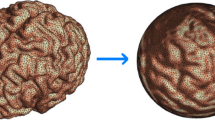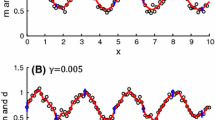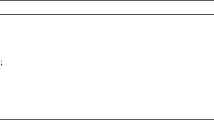Abstract
We are given an image I and a library of templates \({\mathcal{L}}\) , such that \({\mathcal{L}}\) is an overcomplete basis for I. The templates can represent objects, faces, features, analytical functions, or be single pixel templates (canonical templates). There are infinitely many ways to decompose I as a linear combination of the library templates. Each decomposition defines a representation for the image I, given \({\mathcal{L}}\) .
What is an optimal representation for I given \({\mathcal{L}}\) and how to select it? We are motivated to select a sparse/compact representation for I, and to account for occlusions and noise in the image. We present a concave cost function criterion on the linear decomposition coefficients that satisfies our requirements. More specifically, we study a “weighted L norm” with 0 < p < 1. We prove a result that allows us to generate all local minima for the L norm, and the global minimum is obtained by searching through the local ones. Due to the computational complexity, i.e., the large number of local minima, we also study a greedy and iterative “weighted L Matching Pursuit” strategy.
Similar content being viewed by others
References
Barlow, H.B. 1961. The Coding of Sensory Messages. Current Problems in Animal Behavior. Cambridge University Press; Cambridge.
Barrodale, I. and Roberts, F. 1972. Solution of an overdetermined system of equations in the L 1 norm. Math. Dept. Report No. 69, University of Victoria.
Bell, A.J. and Sejnowski, T.J. 1995. An information-maximisation approach to blind separation and blind deconvolution. Neural Computation, 7:1129–1159.
Ben-Arie, J. and Rao, K.R. 1993. On the recognition of occluded shapes and generic faces using multiple-template expansion matching. In Proceedings IEEE International Conference on Pattern Recognition, New York City.
Bergeaud, F. and Mallat, S. 1995. Matching Pursuit of Images. SPIE: Orlando.
Chen, S. and Donoho, D. 1994. Basis Pursuit. TR, Stanford University.
Chen, S. and Donoho, D. 1995. Atomic decomposition by basis pursuit. Technical Report, Stanford University.
Coifman, R. and Wickerhauser, V. 1992. Entropy-based algorithms for best basis selection. IEEE Transactions on Information Theory, 38:2.
Cormen, T.H., Leiserson, C.E., and Rivest, R.L. 1990. Introduction to Algorithms. McGraw-Hill.
Dahlquist, G. and Björck, Å. 1974. Numerical Methods. Prentice-Hall: Englewood Cliffs, N.J.
Donahue, M.J. and Geiger, D. 1993. Template matching and function decomposition using non-minimal spanning Sets. Technical Report, Siemens.
Donahue, M.J., Geiger, D., Hummel R., and Liu, T. 1996. Representations for image decomposition with occlusions. In Proc. Computer Vision and Pattern Recognition, San Francisco, pp. 7–12.
Ekblom, H. 1973. L p -methods for robust regression. BIT 14, pp. 22–32.
Field, D. 1994. What is the goal of sensory coding. Neural Comp. 6, pp. 559–601.
Friedman, J.H. and Stuetzle, W. 1981. Projection pursuit regression. Journal of the American Statistical Association, 76, 817–823.
Grenander, U. 1989. Advances in pattern theory: the 1985 rietz lecture. Annals Statists., 17(1):1–30.
Huber, P.J. 1985. Projection pursuit. The Ann. of Stat., 13(2):435–475.
Huber, P.J. 1981. Robust Statistics. John Wiley & Sons: New York.
Huttenlocher, D., Klanderman, G., and Rucklidge, W. 1993. Comparing images using the hausdorff distance. IEEE Transactions on Pattern Analysis and Machine Intelligence, 15(9):850–863.
Jones, L.K. 1987. On a conjecture of huber concerning the convergence of projection pursuit regression. The Ann. of Stat., 15(2):880–882.
Kirby, M. and Sirovich, L. 1990. Application of the Karhunen-Loève Procedure for the characterization of human face. IEEE Transactions on Pattern Analysis and Machine Intelligence, PAMI-12(1):103–108.
Krumm, J. 1996. Eigenfeatures for planar pose measurement of partially occluded objects. In Proc. Computer Vision and Pattern Recognition, San Francisco, pp. 55–60.
Leonardis, A. and Bischof, H. 1996. Dealing with occlusions in the eigenspace approach. In Proc. Computer Vision and Pattern Recognition, San Francisco, pp. 453–458.
Liu, T., Donahue, M., Geiger, D., and Hummel, R. 1996. Image recognition with occlusions. In Proc. 4th European Conf. on Computer Vision, London.
Mallat, S. and Zhang, Z. 1993. Matching pursuit with Time-Frequency Dictionaries. IEEE Trans. on Signal Processing.
Olshausen, B.A. and Field, D.J. 1996. Natural image statistics and efficient coding. Network: Computation in Neural Systems, 7:333–339.
Poggio, T. and Girosi, F. 1990. Regularization algorithms for learning that are equivalent to multilayer network. Science, 247:978–982.
Poggio, T. and Girosi, F. 1998. A sparse representation for function approximation. Neural Computation, in press.
Rissanen, J. 1978. Modeling by shortest data description. Automatica, 14:465–471.
Rousseeuw, P.J. and Leroy, A. 1987. Robust Regression and Outlier Detection. John Wiley: New York.
Ruderman, D.L. and Bialek, W. 1994. Statistics of natural images: scaling in the woods. Phys. Rev. Letters, 73.
Spyropoulos, K., Kountouzis, E., and Young, A. 1973. Discrete approximation in the L 1 norm. The Computer Journal, 16(2):180–186.
Turk, M. and Pentland, A. 1991. Eigenfaces for recognition. J. of Cognitive Neuroscience, (3):71–86.
Uhrin, B. 1990. An Elementary Constructive Approach to Discrete Linear l p -approximation, 0 < p ≤ + ∞. Colloquia Mathematica Societatis János Bolyai, 58. Approximation Theory, Kecskemét.
Wang, J. and Adelson, E.H. 1994. Representing moving images with layers. IEEE Transactions on Image Processing, 3(5):625–638.
Zhu, S.C., Wu, Y.N., and Mumford, D. 1996. FRAME (filters, random fields, and minimax entropy): Towards a unified theory for texture modeling. In Proc. Comp. Vision and Patt. Recog., San Francisco.
Author information
Authors and Affiliations
Rights and permissions
About this article
Cite this article
Geiger, D., Liu, TL. & Donahue, M.J. Sparse Representations for Image Decompositions. International Journal of Computer Vision 33, 139–156 (1999). https://doi.org/10.1023/A:1008146126392
Issue Date:
DOI: https://doi.org/10.1023/A:1008146126392




